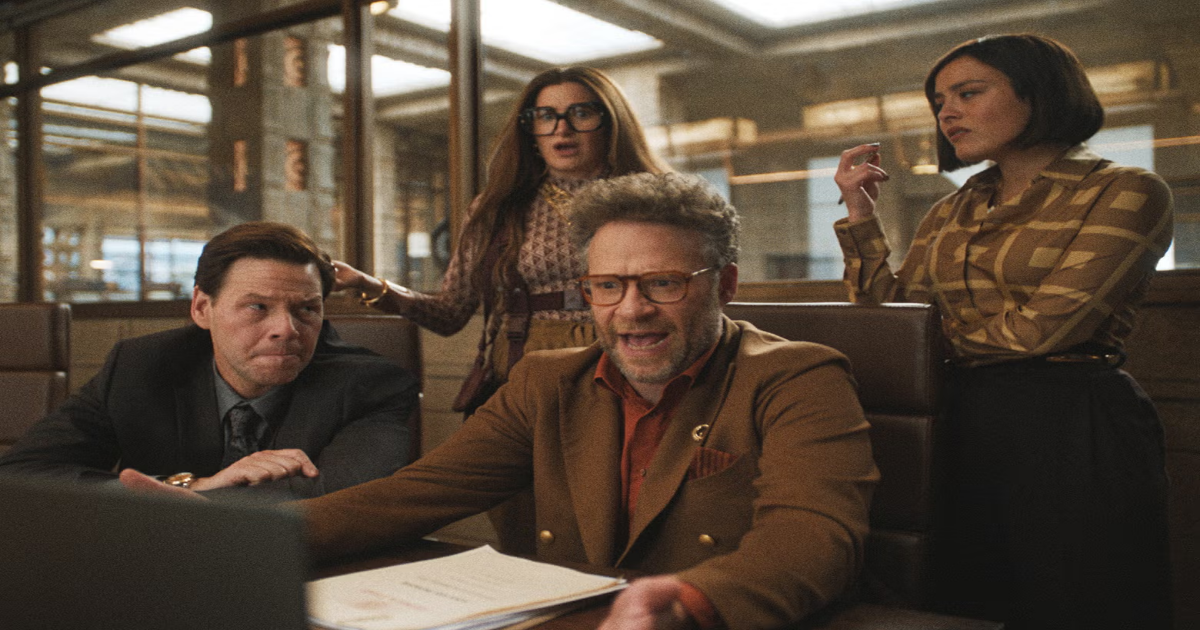What does it mean for a television show to be cinematic? It certainly doesn’t have to mean that the series in question is about the movie business, though that happens to be the case with The Studio, the new Apple TV+ comedy starring Seth Rogen and co-created by Rogen and his longtime creative partner Evan Goldberg (Superbad, Pineapple Express, Neighbors 2). In the first episode, Rogen’s Matt Remick becomes the new president of the venerable century-old Continental Studios when its previous head, industry legend and Matt’s onetime mentor Patty Leigh (Catherine O’Hara), is forced out of the job. Matt got into the business out of a love for classic cinema—he’s forever dropping references to everything from Goodfellas to Fight Club to I Am Cuba. But the realities of the 21st-century box office mean that his workdays revolve around meetings about acquiring the rights to the Kool-Aid brand name for a franchise that will star Ice Cube as the voice of an animated pitcher of red liquid.
The 10 episodes of The Studio’s first season periodically return to the state of this big-budget adaptation of the drink mix, but as a whole, the show’s shape is less serial than episodic—that is to say, nearly every half hour stands on its own as a self-contained story, a minimovie about the making of a fictional movie. That’s only a part of what makes The Studio feel like TV created by filmmakers (Rogen and Goldberg, who co-directed all the episodes). The series is also directed with a level of attention to framing, editing, and camera movement that’s refreshing in the context of weekly television. Episode 2, “The Oner,” chronicles the attempt of filmmaker Sarah Polley—playing herself, in a hilariously cranky turn—to finish a long take before losing the magic-hour light, while a starstruck Matt disrupts the tricky shoot with an unwelcome set visit. That the episode itself is filmed in a single take (or what appears to be one—I won’t quibble with whatever digital or practical work-arounds were used to create that impression) not only pays tribute to the difficulty of orchestrating such a directorial feat but captures the kinetic energy of a film crew operating at full throttle. It’s a lovely example of form suiting function, a match between style and content that recurs in Episode 4, “The Missing Reel,” which pays homage to film noir as it chronicles Olivia Wilde’s attempt to make an arty 35 mm update of Chinatown.
The Studio is not casual second-screen watching: The episodes move fast and demand close attention from the viewer, with throwaway visual jokes crammed into corners of the frame, Simpsons-style. (Rogen and Goldberg are huge fans of The Simpsons and, in the kind of cross-platform deal that’s easy to imagine happening at Continental Studios, once talked co-creator James L. Brooks into letting them write an episode after learning he was a fan of Superbad.) Most scenes are set at the studio’s L.A. headquarters, a sprawling campus designed in warm earth tones that give The Studio a cozier look than your average showbiz satire. In these burnt-ocher halls, Matt spends his days careering from one crisis to the next with his creative team: right-hand-man exec Sal Saperstein (Ike Barinholtz), ambitious protégée Quinn (Chase Sui Wonders), and trendspeak-spouting marketing chief Maya (a resplendent Kathryn Hahn). Except for the final two episodes of the season, which form an arc chronicling the team’s ill-fated trip to Las Vegas CinemaCon, each half hour takes on a separate fictional project connected to a real-life auteur who also appears as him or herself. In addition to the films from Polley and Wilde, there’s Martin Scorsese’s long-dreamed-of epic about the Jonestown cult, Johnny Knoxville’s scatological zombie comedy, and Ron Howard’s self-indulgently long autobiographical drama.
These creators who appear as themselves are not doing mere walk-on cameos but playing significant roles in their respective episodes, and to that end, the showrunners smartly went with filmmakers who have already proved their acting chops. I won’t soon forget Scorsese breaking down in sobs when his pet project falls through, or the moment when Ron Howard, known throughout the industry as an impossibly nice man to work with, brutally roasts Matt in a meeting, culminating in one of the humiliating pratfalls that are among the show’s recurring slapstick gags. (Physical comedy comes into play again in that Vegas-set season finale, with Bryan Cranston as a hedonistic CEO on an epic psychedelic trip: Not since Leonardo DiCaprio’s Quaalude bender in The Wolf of Wall Street has an actor gotten so much comic mileage from a nonfunctioning musculoskeletal system.)
What sets The Studio apart from the many other recent sitcoms that attempt to skewer the entertainment industry is not just its attention to craft and its uniformly strong ensemble cast (Rogen in particular, playing against type as a driven C-suite executive worlds removed from his customary laid-back stoner) but its unironic love for the medium of cinema. While the show’s satire of contemporary Hollywood can be biting, with Matt’s artistic ambitions regularly crashing on the shoals of his company’s bottom line, The Studio never completely sheds its protagonist’s fundamental idealism. “I got into all of this because, you know, I love movies,” Matt tells his industry-veteran mentor after a soul-crushing first few days as the head of Continental. “But now I have this fear that my job is to ruin them.” O’Hara’s Patty—yet another of the great comedienne’s indelible creations—replies with a maxim that could serve, with a slight tweak, as a logline for this wickedly funny yet surprisingly sincere show: “When it all comes together and you make a good movie, it’s good forever.”
Get the best of movies, TV, books, music, and more.

